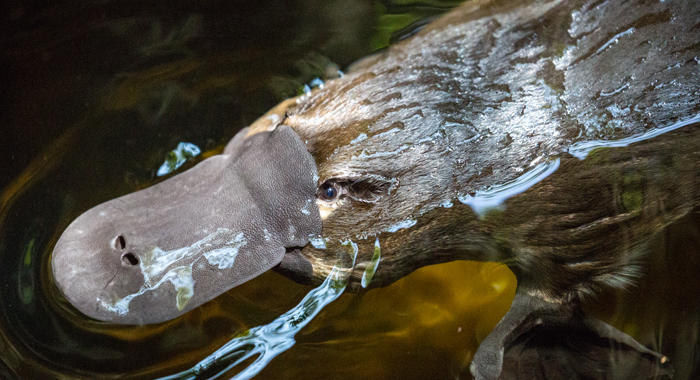tracking the Lockyer Valley’s elusive platypus
tracking the Lockyer Valley’s elusive platypus

9 February 2022 - Landholders along Laidley Creek in Queensland’s Lockyer Valley are being invited to play sleuth and help locate resident platypus by searching for the genetic traces they leave.
Environmental DNA (eDNA) is a relatively new technique for monitoring wildlife that uses the tiny fragments of genetic material that animals leave behind as they move through their environment to track their presence.
The elusive platypus, which shed relatively large amounts of DNA into the water as it goes about its business, make for the perfect candidates.
The survey will be used to build a picture of the local platypus population which little is known about. This will be used to help identify and prioritise conservation efforts to assist the species, such as restoration and reconnection of vital riverside habitat and erosion control.
“Currently we don’t know a great deal about what is happening with platypus in Laidley Creek. There are some past records of platypus in the Lockyer but they are very limited, particularly when it comes to some of the smaller creeks,” says Liz Gould, Principal Scientist at Healthy Land & Water and Board Member of the Great Eastern Ranges.
“We are interested in finding out how the local platypus population is faring, particularly post the 2019-2020 bushfires which we know impacted water quality, and if and how they are using the creek. The survey will help us to get an understanding of what is happening with platypus in the area and to identify opportunities to improve habitat and connectivity.”
Laidley Creek was selected as the first survey site due to its being one of the Lockyer Valley’s priority catchments. Significant investment has already been channelled into managing, restoring and protecting the creek by Healthy Land & Water in partnership with government, community and landholders. If successful, the eDNA survey may be extended into other areas.
Platypus are good indicators of water quality, so the results will also help give ecologists an indication of how successful previous conservation efforts have been.
To kick off the project, Healthy Land & Water is hosting a free platypus workshop for the Lockyer community at Mulgowie Hall on 20 February 2022. Guest speaker and local ecologist Tamielle Brunt from the Wildlife Preservation Society Queensland’s PlatypusWatch Network will introduce locals to the species and her research as well as demonstrate how to sample for eDNA.
The project is being funded through a partnership between the Great Eastern Ranges and the International Fund for Animal Welfare (Australia) as part of a broader bushfire recovery effort.
Other project partners include the Lockyer Uplands Catchments Inc. and the Lockyer Valley Regional Council.
“The task of recovering from the Black Summer bushfires is immense and cannot be achieved by one person or group. By engaging locals and providing them with the information and tools to understand more about wildlife in their area, the community is empowered to be a part of the solution,” IFAW Landscape Conservation Program Officer Wendy Simpson said.
ENDS
Press Contact
IFAW Australia
Dominica Mack
m: 0460 432 901
About the International Fund for Animal Welfare (IFAW) - The International Fund for Animal Wel-fare is a global non-profit helping animal and people thrive together. We are experts and everyday people, working across seas, oceans and in more than 40 countries around the world. We rescue, rehabilitate and release animals, and we restore and protect their natural habitats. The problems we’re up against are urgent and complicated. To solve them, we match fresh thinking with bold ac-tion. We partner with local communities, governments, non-governmental organisations and busi-nesses. Together, we pioneer new and innovative ways to help all species flourish. See how at ifaw.org.
About Healthy Land & Water – Healthy Land & Water (HLW) is an independent for-purpose organisation working to protect and improve waterways and natural asset health in Queensland; an integral part of our lifestyle and economy. With a rapidly growing population and increasingly unpredictable climate, our challenge is to protect our precious natural capital for future generations to enjoy. Healthy Land & Water facilitates careful planning and coordinated efforts at local and regional levels among member organisations from government, industry, landholders, research, and the community to deliver the Healthy Land & Water’s Purpose: “To inspire and connect people with the evidence-based tools and on-ground action that will protect our natural environment and support our economy for future generations." www.hlw.org.au
About the Great Eastern Ranges (GER) initiative - Since 2007, the Great Eastern Ranges has brought people together to stem the loss of native wildlife and their habitats, provide natural solutions to the climate crisis, protect precious resources, and ensure thriving, resilient landscapes and ecosystems for nature and people. Today, we are one of the world’s largest conservation initiatives, delivering robust environmental, health, cultural and socio-economic benefits across eastern Australia through our extensive network of local, regional, and national partners. See how at www.ger.org.au
Related content
Every problem has a solution, every solution needs support.
The problems we face are urgent, complicated, and resistant to change. Real solutions demand creativity, hard work and involvement from people like you.